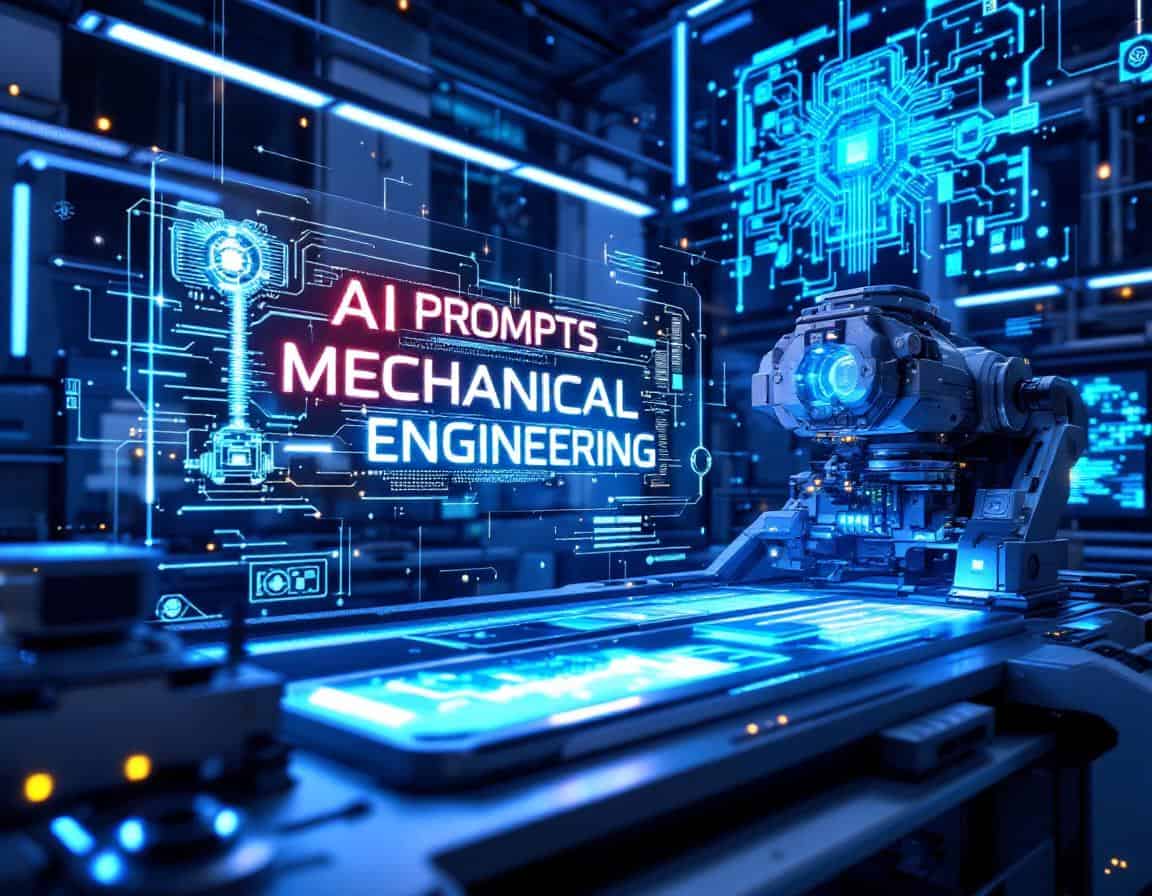
通过增强人类在设计、分析方面的能力,在线人工智能工具正在迅速改变机械工程、 制造业和维护。与传统方法相比,这些人工智能系统可以更快地处理海量数据、识别复杂模式并生成新的解决方案。例如,人工智能可以帮助您优化性能和可制造性设计,加速复杂的模拟,预测材料特性,并自动执行各种分析任务。
The prompts provided below will for example help on generative design, accelerate simulations (FEA/CFD), help on predictive maintenance where AI analyzes sensor data from machinery to forecast potential failures, enabling proactive servicing and minimizing downtime, help on material selection and much more.
- 翻译和语言改编
- 机械工程
人工智能提示 研究摘要简化
- 快速成型制造, 增材制造设计(DfAM), 设计思维, 机械工业, 研究与开发, 用户体验(UX)
将复杂的机械工程主题研究论文摘要简化为通俗易懂的语言,适合普通工程读者或与非专业人士交流。它旨在传达核心信息和意义,而不使用过多的专业术语。输出为文本。
输出:
- 文本
- 不需要实时互联网
- 字段:{研究论文摘要文本}{目标受众描述}{研究论文摘要文本}{目标受众描述}.{目标受众描述}.
- 最适合通过简化技术摘要,让管理人员学生或非专家等更广泛的受众也能了解复杂的机械工程研究。
- 赠款提案和科学写作协助
- 机械工程
人工智能提示 技术报告结构增强器
- 敏捷方法论, 持续改进, 设计过程, 设计思维, 机械工业, 流程改进, 项目管理, 质量管理
此提示可指导人工智能提高机械工程报告中某一章节草稿的清晰度、连贯性和技术严谨性。用户输入草稿文本和报告章节名称,就能得到一个经过改进、结构合理的版本。
输出:
- Markdown
- 不需要实时互联网
- 字段:{草稿文本}{ 节名}
- 最适合最适合快速完善和润色技术报告章节
- 翻译和语言改编
- 机械工程
人工智能提示 多语言词汇生成器
- 面向制造设计 (DfM), 设计思维, 机械工业, 流程改进, 产品开发, 项目管理, 质量管理, 可持续发展实践
以多种目标语言生成用户提供的机械工程术语词汇表。这有助于创建一致的多语言文档和交流。输出为 CSV 格式的词汇表。
输出:
- CSV
- 不需要实时互联网
- 字段:{technical_terms_list_english_csv} {target_languages_iso_codes_csv} 技术术语列表
- 最适合用于创建多语言机械工程术语词汇表,以支持国际项目文档和跨语言的一致术语。
- 赠款提案和科学写作协助
- 机械工程
人工智能提示 赠款预算说明生成器
- 成本分配, 财务, 机械工业, 项目管理, 质量管理, 研究与开发, 可持续发展实践, 价值评估工程(VE)
本提示要求人工智能根据列出预算项目、成本和用途的 CSV 输入表,为机械工程拨款提案生成详细的预算理由说明。它有助于向审核人员清楚地阐述资金需求。
输出:
- 文本
- 不需要实时互联网
- 字段:{csv_budget_items} 预算项目
- 最适合最适合创建清晰、有说服力的预算说明,支持资金申请
- 翻译和语言改编
- 机械工程
人工智能提示 专利申请普通语言改编
- 增材制造设计(DfAM), 创新, 知识产权, 机械工业, 专利, 产品开发, 质量管理, 研究与开发, 以使用者為中心的設計
将正式的专利权利要求改写成通俗易懂的解释,让没有法律或专利领域深厚技术知识的受众也能理解。这有助于传达发明的精髓。输出为文本。
输出:
- 文本
- 不需要实时互联网
- 字段:{专利申请文本}{发明概述}.
- 最适合用通俗易懂的语言为不精通专利法的机械工程师或业务相关人员解释正式专利权利要求的范围和实质。
- 赠款提案和科学写作协助
- 机械工程
人工智能提示 文献综述摘要生成器
- 增材制造设计(DfAM), 优化设计, 机械工业, 流程改进, 质量管理, 研究与开发, 统计分析, 可持续发展实践
本提示要求人工智能对以标题和摘要列表形式提供的与机械工程主题相关的学术论文或文章进行总结和归纳。它可生成结构化的文献综述概述。
输出:
- Markdown
- 需要实时互联网
- 字段:{论文列表}
- 最适合最适合为研究提案快速生成全面的文献综述
- 文献回顾与趋势分析
- 机械工程
人工智能提示 材料进步文献综述
- 快速成型制造, 复合材料, 制造业, 材料, 机械工业, 机械性能, 产品开发, 研究与开发, 可持续发展实践
总结特定类别材料的最新进展(过去 N 年),重点关注其在特定机械工程领域的应用。它能识别关键研究趋势和突破性出版物。输出为标记符摘要。
输出:
- Markdown
- 需要实时互联网
- 字段:{材料类名称} {应用领域重点}{时间段_年}{应用领域_重点
- 最适合为机械工程师提供与其应用领域相关的特定材料类别的最新进展、研究趋势和重要出版物的概述。
- 文献回顾与趋势分析
- 机械工程
人工智能提示 主要研究人员识别工具
- 快速成型制造, 增材制造设计(DfAM), 工程基础, 机械工业, 产品开发, 研究与开发, 机器人技术, 可持续发展实践
确定并列出在某一机械工程专题领域高度活跃的主要研究人员或研究小组及其附属机构。这有助于寻找合作专家或相关文献。输出为 CSV 列表。
输出:
- CSV
- 需要实时互联网
- 字段:{主题机械工程} {所需的结果数量} {所需的结果数量} {所需的结果数量} {所需的结果数量
- 最适合帮助机械工程师确定利基主题领域的领先研究人员和机构,以进行合作专家咨询或文献跟踪。
- 文献回顾与趋势分析
- 机械工程
人工智能提示 设计方法演变分析
- 敏捷方法论, 持续改进, 增材制造设计(DfAM), 六西格玛设计(DfSS), 设计思维, 精益制造, 产品开发, 质量管理
分析和概述特定机械设计方法或理念的历史演变、关键里程碑和当前趋势。这有助于工程师了解设计方法的背景和进步。输出为标记符叙述或时间轴。
输出:
- Markdown
- 需要实时互联网
- 字段:{设计方法名称} {大致起始年份或年代}
- 最适合为机械工程师提供有关特定设计方法如何演变并影响该领域的历史视角和当前理解。
- 文献回顾与趋势分析
- 机械工程
人工智能提示 从摘要中识别知识差距
- 快速成型制造, 增材制造设计(DfAM), 创新, 机械工业, 流程改进, 质量管理, 研究与开发, 可持续发展实践
通过分析最新研究摘要集,确定特定机械工程领域内潜在的知识差距或未来研究领域。这有助于研究人员确定新的研究问题。输出为标记符列表。
输出:
- Markdown
- 不需要实时互联网
- 字段:{研究领域描述文本}{摘要集文本{摘要集文本}{研究领域描述文本}{摘要集文本}.
- 最适合通过分析最新摘要集中的趋势和局限性,帮助研究人员确定机械工程子领域内的新研究问题和知识差距。



























我们是否假设人工智能总能生成机械工程方面的最佳提示?这些提示是如何生成的?
人工智能会让人类工程师变得多余吗?
相关文章
有关 Perovskites 的最新出版物和专利
有关石墨烯的最新出版物和专利
45+ 个游戏和营销科学技巧:数据驱动和统计技巧
Use or Abuse 25 Cognitive Biases in Product Design and Manufacturing
修订的NIOSH工作台人体工程学提升方程
暗网 vs. 暗网 vs. 深网:101 及更多